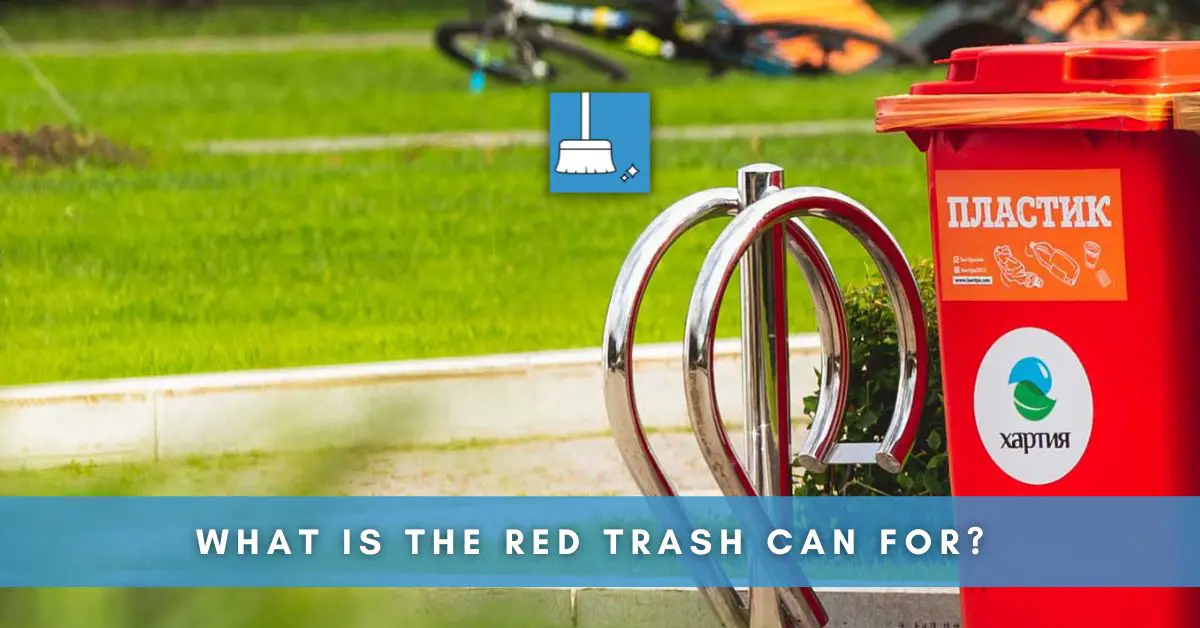Can you tell what material you should dispose of in the red trash can? If the answer is no or maybe, then this blog post is for you! Red trash cans play a significant role in promoting a green environment, reducing harmful waste impact, preventing pollution, and protecting our health. If we understand what goes in and doesn’t go into the red bin, we will be a step closer towards a safer and cleaner planet.
Why the Red Trash Can is Important
Let’s start by understanding why the red trash can is important.
Rather than being your ordinary trash can, the red bin specifically serves to contain hazardous or biohazardous waste, including common medical waste like sharps, expired medications, used gloves, gauze, swabs, and garments soaked with body fluids or blood to name a few.
The errant placement of such wastes in regular trash or incorrectly placing non-hazardous waste in the red bin can lead to health implications and unfit waste management practices.
The Role of Red Trash Cans in Waste Management
In waste management, each color-coded bin signifies a different type of waste. While blue and green trash cans are for dry and wet waste respectively, the red one is geared towards hazardous waste.
Every time a hazardous substance is discarded in a red trash can, it means that’s one less harmful material causing damage to our environment, bodies, and ecosystems.
In essence, the red bin plays a key role in segregating waste, decreasing landfill, and in controlling the inadvertent release of harmful toxins into the environment. This understanding adds up to why we should prioritize correct waste segregation and disposal.
Always remember: Do your part, think before you dispose. No act is too small when it comes to protecting Mother Earth.
Red Trash Can Features
Just like gaming laptops, trash cans are evolving to cater to different needs, and the market offers varied options including the innovatively designed red trash cans.
These aren’t just aesthetically pleasing additions to your space, they offer specific features and qualities, chief among these their durability and varying sizes/capacities.
Durability and Longevity of Red Trash Cans
Red trash cans are well-regarded for their robust construction. They’re made from high quality, commercial-grade resin that lends significant durability and longevity to the product.
Be it a Lavex Janitorial 44 Gallon Trash Can or a 13 Gallon Kitchen Trash Bin, red trash cans are constructed to resist heavy-duty use and handle being dragged over various floor surfaces without cracking.
Furthermore, they are FDA approved and safe for storing food, making them a versatile addition to your establishment.
Different Sizes and Capacities of Red Trash Cans
Red trash cans come in an array of sizes, ranging from small to extra large. The size you choose is contingent upon where you will be using the trash can and the amount of waste you anticipate.
For instance, a 13-gallon trash can is an excellent choice for the kitchen, providing a balance of capacity and footprint.
Applications of Red Trash Cans
Indoor Applications
Inside buildings, whether in homes or commercial establishments, the color of a trash can often signifies its use.
Red trash cans are typically used for biohazard waste, especially in healthcare facilities where the red color quickly and easily indicates potentially risky waste for anyone handling disposal.
A red can in a private home, however, might simply be a design choice or indicate a specific type of waste, like recyclables.
Outdoor Applications
Outdoors, the use of red trash cans might be broader. They may many times be used for general waste. They serve an essential function in facilitating efficient waste management while adding a pop of color to their surroundings.
Benefits of Using Red Trash Cans
Red trash cans, while they may seem like a simple choice of color, can actually provide several advantages in both waste management and maintaining a neat and odor-free environment.
Improved Waste Sorting and Recycling
According to the U.S. Environmental Protection Agency (EPA), increasing recycling and properly segregating trash can cut disposal costs and improve an organization’s bottom line.
Thus, a red trash can effectively aids in waste reduction programs by making waste sorting more straightforward and efficient.
Red Trash Can Regulations
Red bins or red trash cans, despite their vibrant hue, are not usually for ordinary household trash. They play a vital role in the effective and responsible disposal of certain types of waste, as outlined by the waste management authorities.
Local and Municipal Guidelines for Red Trash Cans
In various regions, red trash cans are specifically designated for the disposal of biohazardous waste.
Biohazardous waste refers to waste that could harbor infectious diseases, including but not limited to items like used specimen swabs, needles, and syringes.
These items must be placed in red bins for proper disposal, following the guidelines provided by local or municipal health agencies.
Unused needles, even those that haven’t directly contacted a patient but have punctured IV lines or medicine vials, should be treated as infectious waste.
They are an injury hazard to healthcare personnel and waste workers, and therefore should be bagged separately, identified, and thrown into red trash cans.
Proper Disposal Methods and Handling of Red Trash Cans
Whether it’s a needle, syringe, or any other piece of medical equipment, if it’s deemed hazardous, it should go straight into the red trash can. These items are often placed in a puncture-resistant, leak-proof container before being put into the red bin.
However, it’s important not to dispose of your regular garbage in red bins as this could lead to contamination.
Sharps, particular items that can puncture and scratch, need to be segregated in designated landfills and should never be mixed with regular garbage.
By following these guidelines, we can minimize health risks, protect waste handlers, and contribute to a safer, cleaner, and healthier environment for all.
References
https://www.barstowca.org/departments/community-services-department/environmental-services-division/solid-waste-business/red-tagged
https://consteril.com/red-bag-waste/
https://www.trashcanswarehouse.com/Outdoor-Expanded-Metal-Waste-RED_p_3318.html
https://www.oregon.gov/oha/ph/diseasesconditions/communicabledisease/pages/infectiouswastefaq.aspx
https://rules.sos.ga.gov/gac/391-3-4






